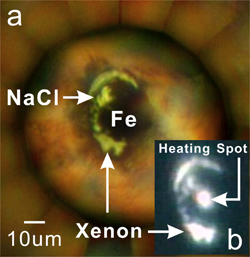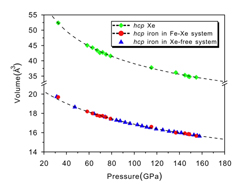Behavior of the Xe-Fe System
above the Metallization Pressure of Xenon
Yagi Group
The behavior of Xe-Fe system was investigated under ultra-high pressures by in situ X-ray diffraction measurements using a laser-heated diamond anvil cell. The so-called missing xenon problem is a long standing, unsolved problem. The Earth’s atmosphere is depleted of helium and xenon, and more than 90% of the expected xenon is “missing” compared to the abundance in the original material of the Earth. Since helium is a light element it readily escapes from the Earth’s gravitational field, but xenon is too heavy to escape. Therefore, the missing xenon is believed to be captured somewhere inside the Earth and various possible mechanisms for this have been discussed. Since the discovery that xenon becomes a metallic solid with an hcp structure above 120 GPa and that iron is also an hcp metal under the same conditions, theoretical studies have proposed that xenon could be trapped in the Earth’s core by forming solid solutions or compounds with iron. So far, however, experiments have been performed only up to about 50 GPa and no studies have been reported at pressures above the metallization pressure of xenon. In this study, we investigated the behavior of the Xe-Fe system up to 155 GPa and 3000 K using a laser-heated diamond anvil cell and synchrotron X-ray radiation, and discussed the possibility for the solid solution in Xe-Fe system at Earth's core pressure[1].

Fig.1. Photographs of the sample chamber observed through the diamond anvil at 155 GPa. Insertion is a view observed during heating above 2000K. Xenon remains transparent even above the metallization and at 155 GPa during the heating.

Fig.2. Volume compression curves of hcp xenon and hcp iron observed at room temperature after the heating. No difference was observed between the volume of iron in two runs with or without xenon, which means no chemical reaction occurs at all between these two hcp metals.
Experiments were performed by high-pressure in situ X-ray diffraction using a laser-heated diamond anvil cell combined with synchrotron radiation. Beveled anvils with 100-300 μm culets was mainly used. Pure iron and a NaCl pellet, which works as a thermal insulator as well as a pressure marker, were placed in the gasket hole, together with Xe with a purity of 99.999%. Loading of Xe was made cryogenically. Heating was conducted using focused fiber lasers from two sides of the sample so as to heat a 10-20 μm diameter spot. Figure 1 shows the sample chamber at 155 GPa and room temperature, together with that at 2000 K (insertion). Even above the metallization of Xe at about 120 GPa, it remains transparent in this thickness.
Angle-dispersive XRD measurements were conducted at high pressure and high/room temperature using the BL10XU beam line of the SPring-8. Clear diffractions of xenon, iron and NaCl were observed in the entire range of pressure and temperature and no additional diffraction was observed even after heating the samples to 3000 K at 155 GPa. This fact clearly indicates that no new compound was formed even under these extreme conditions. Figure 2 shows the volume compressions of hcp xenon and hcp iron observed at room temperature after the heating. Volume compressions of iron were repeated with and without xenon, and no difference of volumes were observed at all between them. This fact clearly indicates that no dissolution of xenon into iron occurred even though both of these two material became the same hcp metals. The unit cell volumes of the two hcp metals, xenon and iron, differ by more than 100% even at about 155 GPa, which means that the atomic sizes of these two metals differ more than 30%. This is probably the reason why no dissolution occurs in this system even after the metallization of xenon. Present results suggest that some mechanism other than the dissolution in the Earth’s core has to be considered to solve the “missing xenon problem”.
References
- D. Nishio-Hamane, T. Yagi, N. Sata, T. Fujita, and T. Okada, Geophys.Res. Lett. 37, L04302 (2010).
